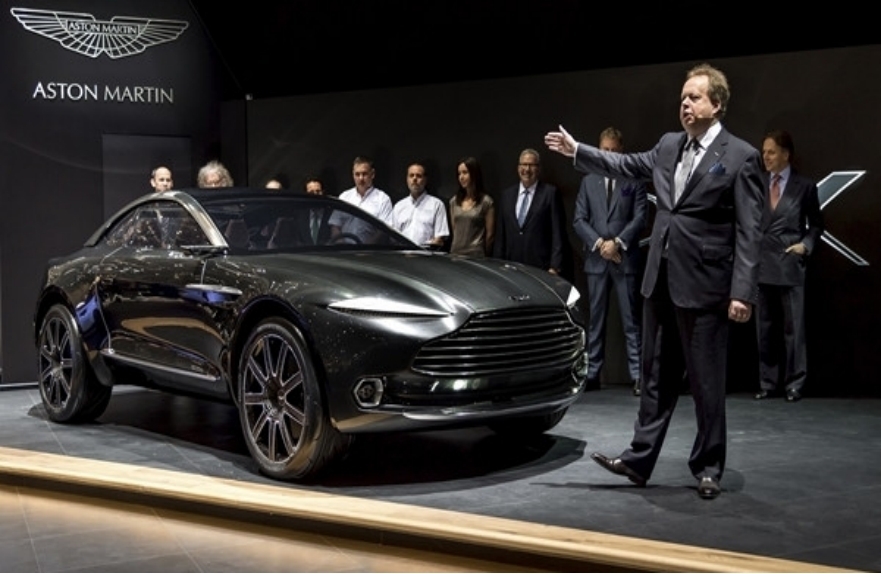
In the wave of new energy vehicles sweeping the world today, the trend of British supercar manufacturer Aston Martin has undoubtedly attracted a lot of attention. The long-established automaker has been publicly teasing its electric vehicle ambitions for years, but it hasn't stalled on the ground. Aston Martin has partnered with US carmaker Lucid to provide battery and motor technology to help it build electric vehicles. This move undoubtedly shows Aston Martin's layout and ambition in the field of electric vehicles.
Surprisingly, however, Aston Martin's first electric car is not a sports car, which it is good at, but an SUV. This decision has undoubtedly caused a lot of controversy. After all, in many people's minds, Aston Martin is synonymous with luxury sports cars, and SUVs seem to be at odds with the brand image. But regardless, the decision is firmly in the works, and after many delays, company boss Adrian Hallmark has finally confirmed that Aston Martin will have an electric car on the road by 2030.
In talking about the electric vehicle, Hallmark revealed a novel design approach designed to give electric vehicles a real emotional connection with driving purists. Instead of mimicking engine noise or fake manual gearboxes, which are common in modern electric cars, he decided to make the car vibrate. According to a report from Autocar, this vibration will simulate the sensation a driver feels inside a V12-powered Aston sports car, without directly mimics the rumble of the engine.
This design concept sounds rather novel, even somewhat convoluted. But Aston Martin seems pretty serious about it. They plan to map telemetry data from the V12 engine of the Valkyrie sports car, measure its frequency, and build it into the body structure of the electric vehicle. When the driver operates the throttle, these frequencies are linked to the throttle position and suppress electrical frequency noise, creating a sensation in the driver similar to that found in Valkyrie or other 12-cylinder cars.
"I believe that without false noise, but by actually using the frequency of the internal combustion engine powertrain to oscillate body structures and other structures, we can create an emotional connection." The claim sounds sci-fi and may even be reminiscent of safe-search warnings on some computers. But Aston Martin is clearly confident, and is hoping to impress driving purists who are skeptical of electric cars in this way.
However, is this design concept really feasible? First, we need to be clear that vibration alone is not enough to fully simulate the driving experience of an internal combustion engine car. The appeal of internal combustion engine cars lies not only in the sound or vibration of the engine, but also in the sense of pushing back when accelerating, the feeling of stopping when shifting, and the overall dynamic responsiveness. These feelings are difficult to fully replicate with electric cars, which have a smoother and more linear power output.
Moreover, even if Aston Martin were able to simulate some of the sensations of an internal combustion engine car through vibration, the simulation would necessarily be limited. Because the vibration itself is affected by a variety of factors, such as body structure, suspension system, seat material and so on. Different drivers experience vibrations differently. Therefore, it is difficult to guarantee that every driver can obtain a driving experience similar to that of an internal combustion engine car through vibration.
Now look at Aston Martin's challenge in the lightweight of electric vehicles. A notable feature of electric vehicles is the large weight of their battery packs. In general, the average weight of the battery pack is between 700-800 kg, while the weight of the ordinary engine is only about 150 kg. This makes electric vehicles face a huge challenge in terms of lightweight. Lightweight is crucial for high-performance cars, because it directly affects the acceleration performance, handling and driving range of the car.
Adrian Hallmark also recognizes this and says that solid-state batteries could be the key to solving this problem. Solid-state batteries have a higher energy density and lower weight than traditional liquid batteries. Therefore, if Aston Martin can successfully apply solid-state battery technology, then they have the potential to significantly reduce the weight of electric vehicles and thus improve their performance. However, solid-state battery technology is still in the research and development stage, and there is still a certain distance from commercial application. As a result, Aston Martin's efforts at lightweight are still some way off.
In addition to solid-state battery technology, 3D printing is also a direction Aston Martin is exploring in terms of lightweight. With 3D printing technology, they can precisely manufacture car parts as needed, thereby avoiding material redundancy and waste. This can not only reduce the weight of the car, but also improve the accuracy and reliability of the components. However, the application of 3D printing technology in the field of automotive manufacturing is still in its infancy, and its cost and efficiency issues still need to be further addressed.
Aston Martin is also looking at using technologies such as four-wheel steering and other electronics to replicate the advantages internal combustion engine cars have gained in terms of lightweight. Four-wheel steering technology can improve the handling and stability of the car, while electronic devices can provide richer driving assistance functions. However, the introduction of these technologies will also increase the complexity and cost of the car. Therefore, Aston Martin needs to find a balance between technology introduction and cost control.
To sum up, Aston Martin's efforts in the field of electric vehicles, while full of creativity and ambition, also face many challenges and problems. From a technology point of view, they need to conduct in-depth research and exploration in vibration simulation, lightweight technology, solid-state batteries, 3D printing, and electronic devices. At the same time, they also need to find the best balance between cost control and user experience. Only in this way can Aston Martin achieve a real breakthrough and success in the field of electric vehicles.
Of course, as a car manufacturer with a long history, Aston Martin has accumulated a lot of experience and technology in the field of fuel vehicles. These experiences and technologies undoubtedly have important reference value for their exploration in the field of electric vehicles. But we should also see that there are huge differences between electric vehicles and fuel vehicles in terms of technology and market. As a result, Aston Martin needs to abandon the inertia of its past success and approach the challenges and opportunities in the field of electric vehicles with a fresh perspective and way of thinking.

YTN TV of South Korea reported on Tuesday (December 16) that the South Korean court plans to make a ruling on the charges of former President Yoon Suk Yeol for obstructing justice on January 16, 2026.
YTN TV of South Korea reported on Tuesday (December 16) tha…
On December 7, a new round of intense military conflict bro…
Recently, US media disclosed that the Pentagon is planning …
From three launch failures and a brush with bankruptcy to n…
Recently, a major piece of news has emerged in the US polit…
Against the backdrop of the Federal Reserve's third rate cu…